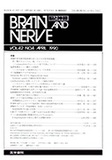Japanese
English
- 有料閲覧
- Abstract 文献概要
- 1ページ目 Look Inside
自然発症性高血圧ラットの両側総頸動脈を結紮する事により不完全脳虚血を作成し,脳虚血前後の血糖値,脳表血流量の変化,脳組織の解糖活性およびFructose 2,6—bisphosphate等の解糖活性調節因子の変動について検討した。脳組織中の解糖代謝中間体さらにPyridineおよびAdenide nucleotideの濃度変化から,総頸動脈結紮30分後より脳表血流量低下にともなって,脳組織に生化学的な虚血性の変化が起こっている事が明らかとなった。一方,解糖活性は総頸動脈結紮15分後より60分まで増加したが,60分以降は徐々に低下した。解糖系の強力な活性化因子であるFructose 2,6—bisphosphateは,解糖活性上昇に先駆けて総頸動脈結紮15分,30分後に増加し,これに従うようにFructose 1,6—bisphosphate, AMPが増加した。これは虚血時の解糖活性の亢進にFructose 2,6—bisphosphateが中心的な役割を果たしている事を示している。また解糖代謝中間体等の分析の結果,虚血早期に観察されるFructose 2,6—bisphosphateの上昇は,血糖値の上昇による脳組織中のGlucose濃度の増加が主な原因と考えられ,虚血時における血糖値の増加は虚血性脳組織の解糖代謝を考える際重要な意味を持っていると考えられる。
The brain ischemia of spontaneously hyperten-sive rat was produced gradually by bilateral ligation of the common carotid arteries. The cortical blood flow was meaured with a laser doppler flowmeter before and after ligation of the arteries. At the specified intervals, the brain was frozen in situ with liquid nitrogen. The concentration of blood glucose and glycolytic intermediates in frozen brain were measured and the relationship between glycolytic activity and the concentrations of effectors to PFK-1, such as fructose 2, 6-bisphosphate, fructose 1, 6-bispho-sphate, AMP, ATP, Pi and citrate, was inves-tigated. The changes in glycolytic intermediates, pyridine and adenine nucleotides concentration showed that ischemic change occured in the brain tissue after 30 min of bilateral ligation of the common carotid arteries, in correlation with the decrease in cortical blood flow. The rate of lactate formation increased during the 30-60 min interval and finally decreased during 60-120 min period of ischemia. This indicates that anaerobic glycolysis was accelerated during the early stages of ischemia. The most potent activator of PFK-1, fructose 2, 6-bisphosphate, in creased from 5. 3 of 6.7 nmol/g during the initial stage of ische-mia, and this change preceded the activation of glycolysis and the increase in fructose 1, 6-bis-phosphate concentration, a result indicated that fructose 2, 6-bisphosphate does participate in the activation of glycolysis during brain ischemia in vivo. And it is conceivable that the fructose 2, 6-bisphosphate content increase may be due to the rise in concentrations of glucose and hexose 6-phosphate in brain tissue, which occur-red as a result of the blood glucose level ele-vation by nervous and hormonal responses to the ligation of the carotid arteries. It is concluded that the elevation of blood glucose level was an important response to prevent the depletion of energy producing ability in the early stage of ischemia.

Copyright © 1990, Igaku-Shoin Ltd. All rights reserved.


